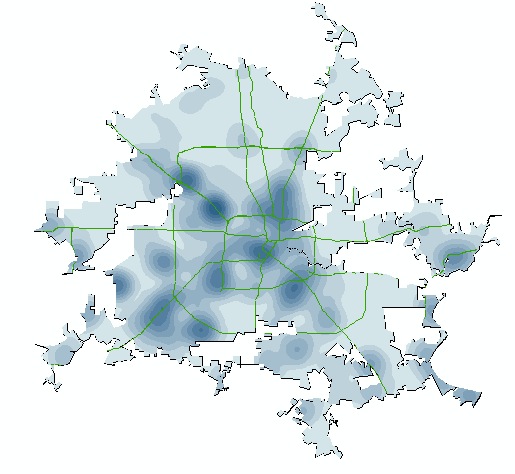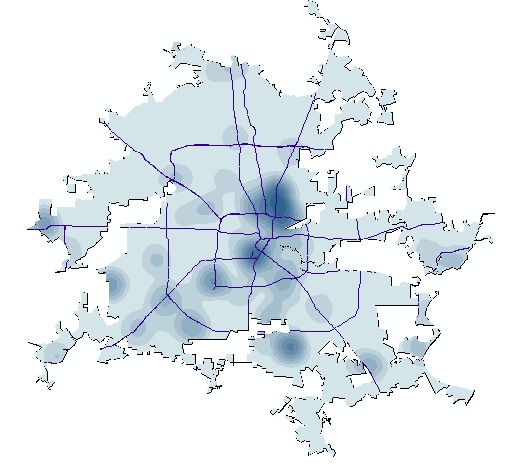Module 3 Project 1
Q1)
What geographic
area are you studying?
Houston, Texas
Q2) What decision do you need to make?
Decision support for deployment of law enforcement assets.
Q3) What information would help you make the decision?
Current location of all assets.
Geocoded location of past types, dates, location of criminal activity.
Q4) Who are the key stakeholders for this issue? (This step is important. You need to know the audience for your analysis to help decide how to present your results.)
The management of law enforcement.
Q5) Investigate the metadata and complete this table:
Q6) Were there any unmatched addresses?
One tie.
Q7) How many of the addresses were unmatched?
One.
Q8) How many total crimes were there?
9,448 (regardless of date).
Q9) What percentage of the crimes were unmatched?
31%.
Q10) How many records are not from August 2006?
2,614.
Q11) How many crime records are listed?
6,834.
Q12) Can multiple records (crime incidents) occur at the same location? Give an example.
Yes. 11th ave. 8-11-06 Robbery / 11th ave. 8-9-06 Burglary of Vehicle
Q13) Can you suggest a reason for this?
Crimes may happen more than once at a location. Also large residential complex's may have the same address.
Q14) How is the Offense_Time represented?
24 hour clock.
Q15) What are the offenses recorded?
Q16) Complete this table on your worksheet:
Hint: Use the Sum_event field. Remember, there are 6,834 crimes.
Q17) What do these results tell the police department about the distribution of crime?
Crime increased in the four mile zone please see map.
Q18) Use the attribute table of pol_sta_crimes to complete this table:
Remember, there are 6,834 crimes.

Q19) What does this method tell the police department about the distribution of crime?
Areas such as Clear Lake, Fondren, And Southeast may need more support. While Kingwood has such a statistically low rate of crime it might be able to give up some of its assets.
Q20) Compare the two methods of analysis.
Q21) Write a spatial analysis of crimes and police stations.
Q22) How many burglaries have been reported?
1,417.
Q23) What is the spatial distribution of burglaries in Houston?




6,834
Q27) Calculate crime for various time periods by completing this table:
Q28) What time of day is crime the lowest?
Morning. (see above)
Q29) What time of day is crime the highest?
Evening. (see above)
Q30) How many schools do not have any crime within the 1,000-foot zone?
241
Q31) What school has the highest number of crimes?
Q32) Select that school and see which crimes were committed.
Q33) Is the drug-free zone effective?
There were 241 various crimes out of 6,834. That is 3.53% of the crime in Houston.
Q34) How could you design a study to find out what is going on just outside the zone?
Investigate what are the unanswered questions outside the zone. Also what are the particular issues that spatial information analysis can reveal. Once this is discovered then a design can be made and data procured.
Houston, Texas
Q2) What decision do you need to make?
Decision support for deployment of law enforcement assets.
Q3) What information would help you make the decision?
Current location of all assets.
Geocoded location of past types, dates, location of criminal activity.
Q4) Who are the key stakeholders for this issue? (This step is important. You need to know the audience for your analysis to help decide how to present your results.)
The management of law enforcement.
Q5) Investigate the metadata and complete this table:
| Layer | Data Type | Publication Information: Who Created the Data? | Time Period Data is Relevant | Spatial Horizontal Coordinate System | Attribut Values |
| aug06.xls | Excel worksheet | http://www.houstontx.gov/police/stats.htm | 2006 | N/A | Crime Records |
| blkgrp | Line | Tele Atlas North America, Inc., ESRI | 2005 | GCS_WGS 1984 | Census data |
| houston |
Polygon | Census Bureau, ESRI | 2003 | GCS_WGS 1984 | Census data |
| usa_sts | Line | Tele Atlas North America, Inc., ESRI | 2003 | Geographic | Street Data |
Q6) Were there any unmatched addresses?
One tie.
Q7) How many of the addresses were unmatched?
One.
Q8) How many total crimes were there?
9,448 (regardless of date).
Q9) What percentage of the crimes were unmatched?
31%.
Q10) How many records are not from August 2006?
2,614.
Q11) How many crime records are listed?
6,834.
Q12) Can multiple records (crime incidents) occur at the same location? Give an example.
Yes. 11th ave. 8-11-06 Robbery / 11th ave. 8-9-06 Burglary of Vehicle
Q13) Can you suggest a reason for this?
Crimes may happen more than once at a location. Also large residential complex's may have the same address.
Q14) How is the Offense_Time represented?
24 hour clock.
Q15) What are the offenses recorded?
| Old Name | New Name |
| Aggravated Assault | Assault |
| Auto Theft | Auto Theft |
| Burglary of a Motor Vehicle | Burglary/Auto |
| Narcotic Drug Laws | Drugs |
| Driving While Intoxicated | DWI |
| Murder & Non negligent Manslaughter | Murder |
| Forcible Rape | Rape |
| Robbery | Robbery |
Q16) Complete this table on your worksheet:
Hint: Use the Sum_event field. Remember, there are 6,834 crimes.
| Distance | 1st Attempt | Percentage | 2nd Attempt | Percentage | 3rd Attempt | Percentage |
| 2 Miles | 1085 | 15.88% | 1143 | 16.73% | 1027 | 15.03% |
| 4 Miles | 1792 | 15.88% | 1889 | 16.73% | 1707 | 15.03% |
| 6 Miles | 1528 | 22.36% | 1673 | 24.48% | 1295 | 18.95% |
| More than 6 Miles | 2429 | 35.54% | 2129 | 31.15% | 2805 | 41.04% |
| Total | 6834 | 89.65% | 6834 | 89.08% | 6834 | 10.05% |
Q17) What do these results tell the police department about the distribution of crime?
Crime increased in the four mile zone please see map.
Q18) Use the attribute table of pol_sta_crimes to complete this table:
Remember, there are 6,834 crimes.

Q19) What does this method tell the police department about the distribution of crime?
Areas such as Clear Lake, Fondren, And Southeast may need more support. While Kingwood has such a statistically low rate of crime it might be able to give up some of its assets.
Q20) Compare the two methods of analysis.
Q21) Write a spatial analysis of crimes and police stations.
Q22) How many burglaries have been reported?
1,417.
Q23) What is the spatial distribution of burglaries in Houston?
Burglaries


Drug
Crimes


Aggravated
Assault
Crimes


Q26)
What is the total number
of crimes?

6,834
Q27) Calculate crime for various time periods by completing this table:
Q28) What time of day is crime the lowest?
Morning. (see above)
Q29) What time of day is crime the highest?
Evening. (see above)
Q30) How many schools do not have any crime within the 1,000-foot zone?
241
Q31) What school has the highest number of crimes?
Q32) Select that school and see which crimes were committed.
| Name of Crime | Number of Crimes |
| Aggravated Assault | 4 |
| Auto Theft | 14 |
| Burglary | 14 |
| Burglary of a Motor Vehicle | 3 |
| Narcotic Drug Laws | 5 |
| Robbery | 13 |
| Total | 53 |
Q33) Is the drug-free zone effective?
There were 241 various crimes out of 6,834. That is 3.53% of the crime in Houston.
Q34) How could you design a study to find out what is going on just outside the zone?
Investigate what are the unanswered questions outside the zone. Also what are the particular issues that spatial information analysis can reveal. Once this is discovered then a design can be made and data procured.